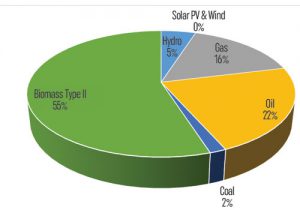Myanmar’s energy sector will require investment of between US$30 billion and $40 billion over the next 15 to 20 years, and should focus on coal power, according to the government’s Energy Master Plan, published last month.
Myanmar’s energy mix in 2015. Source: Energy Master Plan
Domestic energy consumption is forecast to almost double to 21.9 million tonnes of oil equivalent (mtoe) in 2030 from 12.2mtoe in 2012, said the report, which was written with guidance from the National Energy Management Committee.
To meet this demand the master plan aims to develop a mix of energy sources to provide a stable and reliable energy supply through to 2030. By this time, according to projections made in the plan, Myanmar will have a population of 73.7 million and gross domestic product of $187.9 billion.
The government hopes its plan will ensure efficient use of the country’s wealth of natural resources, create a good investment environment, and minimise environmental and social damage.
By 2030, it targets the following energy mix: 33 percent biomass, 22pc oil, 20pc coal, 13pc gas, 11pc hydro and 1pc renewable energy.
An official for a leading international oil company in Myanmar welcomed the master plan, but did not recommend such an emphasis on coal.
“The Energy Master Plan clearly underestimates the potential of gas development which I believe should be prioritised along with hydropower,” he said.
“Developing coal in Myanmar would be a big mistake. Myanmar might be one of the bigger losers in the world [in terms of] CO2 emissions and climate change.”
The Japan International Cooperation Agency has also published a report suggesting huge development of coal in Myanmar, he said. On its website, JICA says Myanmar “should be open-minded about all possibilities, including coal”.
The master plan does not seem to give much thought to renewable energy sources, added the oil company official.
The plan is based on an assumption that all Myanmar’s electricity needs can be met by local power plants, with all new power plants to be fuelled by imported bituminous coal. The report recommends a local oil refinery with a capacity of 50,000 barrels per day (bpd) should begin operations in 2019, to be built somewhere in central Myanmar. The government has the right to use this amount of oil from the China-Myanmar pipline that runs from Rakhine State to Yunnan province.
Meanwhile, Thailand’s state-owned PTTEP will suspend operations at its offshore M3 gas field in the Gulf of Martaban, as global oil prices hit new lows, with no new fields to begin operations. Fertiliser and LPG, or liquefied petroleum gas, will be imported from 2018.
The new oil refinery will cost $1.2 billion and another $11 billion to $17 billion will need to be spent on other projects, the report said.
For Ken Tun, chief executive officer of Parami Energy Group, the proposed oil refinery is too small. “A capacity of 50,000bpd is not efficient,” he said, adding that refineries should have a capacity of at least 150,000bpd to run commercially and efficiently.
The energy mix outlined in the Energy Master Plan, which was drafted with direct and indirect input from a number of international financial institutions, should be reconsidered, he said.
Projected energy mix by 2030. Source: Energy Master Plan
“The master plan has a large focus on coal and much less on renewable energy. Coal should not [account for] 33pc and renewables should be prioritised, with at least 50pc,” said Ken Tun.
The Energy Master Plan also outlines barriers to attracting investment into the energy sector. Tariffs must be cost-reflective to ensure adequate returns, laws must protect private assets and transparency through mechanisms such auctions is needed, it said.
The plan recommends that the government ensure a legal and regulatory framework is in place meeting international standards. The private sector will be more likely to participate if risks are minimised and legal rights and privileges are enforceable, it said.
Environmental standards must be in place and the government should continue to develop mechanisms for reporting compliance in a transparent way, it said, with the help of civil society and environmental groups.
The plan also mentions that local acceptance of large hydropower projects and gas pipelines has diminished in recent years due to a mistrust of project developers – local residents claim they receive no direct benefits from energy development projects.
The future of hydropower development in particular will be tied to the development of greater social acceptance, it said, adding that the government will explore opportunities for local residents to share the benefits of energy development.
For Ken Tun, the plan does not focus enough on energy exports or on regional cooperation. The government should outline its export strategy, he said, and should also reconsider building 500-kilovolt transmission lines to bring in more capital investment and further support hydropower development.
On the positive side, the master plan aims to bring electricity to the 70pc of the population living in rural areas, he said. “It is likely to cover these areas with rural electrification as the first priority.”
Source: MYANMAR TIMES (By Aung Shin | Monday, 08 February 2016)


